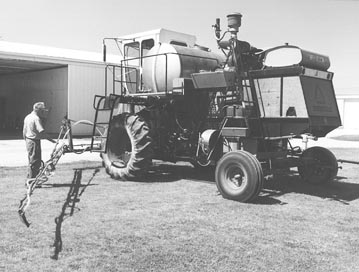If you've ever considered building a self-propelled crop sprayer out of an old combine, you might want to listen to Richard Cox who turned a 1975 M Gleaner with hydrostatic drive into a fast, smooth-riding spray rig. The Franklin, Ill., farmer says Gleaners are the best machines to use. "What I like about Gleaners for this purpose is their big, heavy-built channel iron frames," Cox says. "The tin work isn't used to hold them together like some other combines, so you can remove just about everything and they remain structurally sound." He started by removing the header and all grain-cleaning components from the machine, which he bought specifically to build the sprayer. He shortened the rear end of the combine by 2 ft. so it would better fit into his machine shed. The sprayer is equipped with a commercial 54-ft. boom with 21-ft. wings and 12-ft. middle section. Nozzles are on 20-in. spacings for broadcasting pre-emerge and post herbicides on 700 acres of drilled beans and 700 acres of corn on 36-in. rows. The front-mounted boom mounts on a shock-absorbing bracket Cox built out of steel tubing and strap iron. It's equipped with a used combine header spring on each side to reduce bounce, as are larger 18.4 by 34-in. tires that he installed. "There's hardly any bounce to the boom. And front-mounting allows the operator to clearly see every nozzle," Cox notes. "The taller, narrower front tires smooth out the ride and allow you to operate in drilled beans without running as many down. Plus, they gear it up faster for field speeds of up to 11 mph." Cox removed the combine's grain tank and replaced it with an 800-gal. tank he found at a farm sale. The 8 ft. long by 4 ft. dia. stainless steel tank is ideal for the M Gleaner, he says. A big, shop-type air compressor is installed on the left side of the machine to power the marker system and to clean nozzles. It runs off the clutch that originally powered the header and is connected to a 30-gal. tank mounted inside the rear of the combine. "Running at field speeds of up to 11 mph, we can spray 300 acres in a short day, no problem," Cox says.
1-800-834-9665
Best Way To Make A Combine Sprayer
FARM SHOW Magazine » Best Way To Make A Combine Sprayer
Best Way To Make A Combine Sprayer
